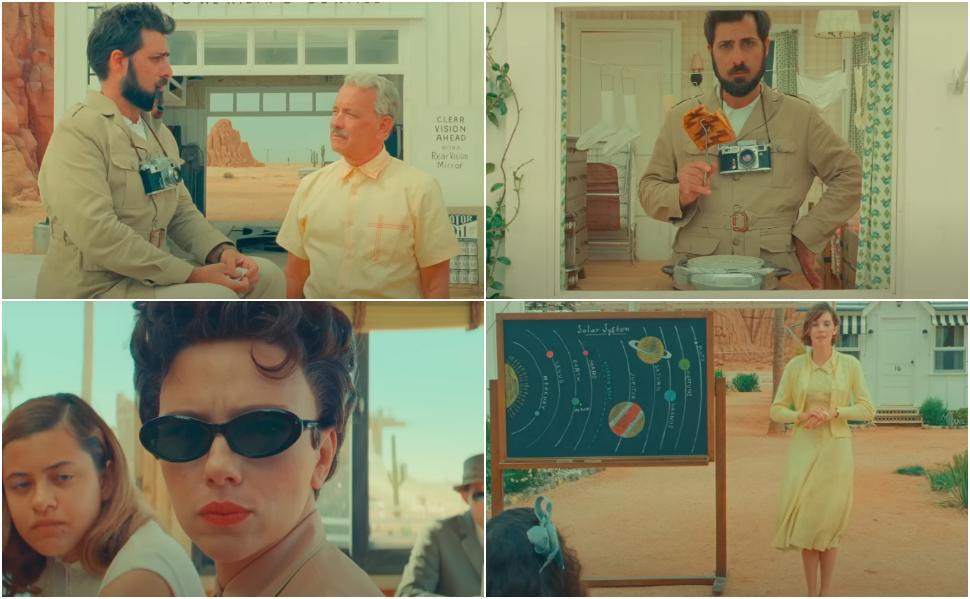Asteroid City is one of those movies that you realize pretty much right away won’t be for everyone. Judging by reactions I’ve seen online, it’s a film that some people will love and other people will hate. Some will find it amusing and quirky in all the right ways, while others will be baffled by its monotone delivery and slow pace.
I thought it was a masterpiece from beginning to end, and it’s instantly become one of my favorite Wes Anderson pictures, though I’d have to rewatch all of them to craft a true ranking. It’s been many years since I’ve seen The Royal Tenenbaums or The Life Aquatic, for instance. Or even more recent Anderson flicks, like Moonrise Kingdom or The Grand Budapest Hotel.
Asteroid City is a movie-within-a-play-within-a-movie, though that doesn’t quite capture the structure of the film. There is a narrator of sorts (played by Bryan Cranston) who tells the story of the playwright, Conrad Earp (played by Edward Norton). All of Earp’s scenes are in black and white, as are any of the scenes that take place in the world of the play, which is being directed by Schubert Green (Adrien Brody).
The actors we encounter in the main film—which is effectively a film version of the play—are sometimes encountered in these black and white scenes. So Jason Schwartzman plays not just Augie Steenbeck, but also actor Jones Hall; Scarlett Johansson, meanwhile, plays Mercedes Ford the actress (in black and white) who plays Midge Campbell (in color) who also happens to be a movie star. An actress playing an actress playing an actress, like some theatrical Russian Doll.
If all of this sounds confusing, well, it is a little confusing. But it opens doors to all sorts of clever scenes and conversations.
And that’s really what this is: A film about people standing around talking with one other. Often these moments feel disconnected and even a little abstract or silly. A police car chase that you think will surely be explained later in the film never is—like some anti-Chekov’s gun.
Mostly, these conversations take place in the retro-futuristic Asteroid City, a pastel tumbleweed desert town that’s just a cratered blip on the map; a roadside destination for stargazers and random passersby. Sometimes, they’re set backstage. At one point, a character leaves the “movie” portion during a climactic scene, walks through a door and pulls a reverse Dorothy in Oz, leaving the colorful Asteroid City to walk into the black and white of Broadway.
The film’s dual plots interweave cleverly throughout, with the whole thing broken up into Acts and Scenes, segmented with title cards. The basic story in the main plot is simple enough. Several families arrive at Asteroid City to observe an astral phenomenon and to present their inventions. There’s a bit of Moonlight Kingdom’s vibe here, with a lot of focus on the younger cast. But it’s really a story about loss and grief, and tucked away in a sea of cameos (seriously, has any movie ever had this many big stars?) it’s mostly about Augie and Midge and the way these two lonely people come together in the unlikeliest of places.
Because of the film’s structure, however, the key emotional moment in the film takes place not between these two, but rather in black and white, between Jones and the actress who was supposed to play his wife in the play, but whose role was cut. I won’t spoil it beyond that. Suffice to say, I was surprised at how moved I was by this strange encounter.
Again, I realize that Asteroid City isn’t for everyone, that some will leave scratching their heads, baffled or annoyed. I, however, found it at once delightfully quirky, genuinely hilarious and profoundly sad. It was also peak Wes Anderson, which you can tell from just watching the trailers. In many ways, I’m glad to see him push his filmmaking style to its limits here, though I wonder if perhaps it might be time for the auteur director to ease back on the pedal a bit for his next film.
Score: 6/7 Blinking Lights
What did you think of Asteroid City? Let me know on Threads, Twitter and Facebook. Also be sure to subscribe to my YouTube channel and follow me here on this blog. You can also sign up for my Substack newsletter, Diabolical.
Read the full article here





